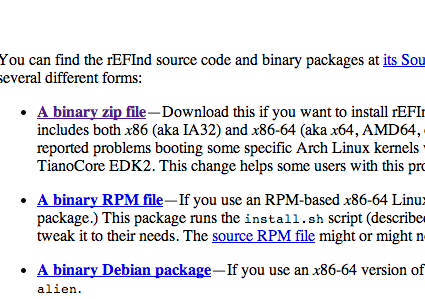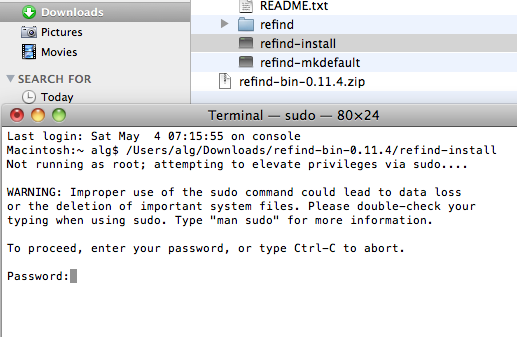Tutorial to set up multi-boot of Windows, Linux and Mac using rEFInd and EasyUEFI. Download rEFInd from rEFInd's official website, and unzip it if it is a compressed package. Download, install and run EasyUEFI, click the button, and then click the button.
- # banner - the rEFInd title banner (built-in or loaded via 'banner') # label - boot option text label in the menu # singleuser - remove the submenu options to boot Mac OS X in single-user # or verbose modes; affects ONLY MacOS X # safemode - remove the submenu option to boot Mac OS X in 'safe mode'.
- Refind (rEFInd) on Mac High Sierra/Leap 15.2. Hardware is mid-2011 Mac Mini. Partitioned Mac, installed Refind, then Leap 15.2 OS. Nothing after restart from Leap install. Used option key cold start to get back into Mac OS. Reinstalled Refind, restarted and was able to choose Leap from Refind menu. After doing usual post-install config stuff in.
- RefindPlus is a variant of the rEFInd Boot Manager incorporating various fixes and additional features. However, the enhancements RefindPlus adds to rEFInd are not limited in scope to those units and may be of interest to anyone requiring a capable and flexible boot manager, particularly if running Mac OS.
rEFIt is a boot menu and maintenance toolkit forEFI-basedmachines like theIntel Macs.You can use it to boot multiple operating systems easily,including triple-boot setups with Boot Camp.It also provides an easy way to enter and explorethe EFI pre-boot environment.
On this page:News- Download- Troubleshooting- Resources
Other pages:Documentation- Troubleshooting- Screenshot- Myths and Facts

News
2013-03-29: As you may have noticed, rEFIt is no longer activelymaintained. Please check outrEFInd,a fork that is maintaned and under active development.
2010-03-12: The site has a newtroubleshooting section.Some common problems are also listed below.
2010-03-07: Version 0.14 was released. This release adds a configurationoption for the default boot choice, fixes the Linux/GRUB detection issue, andfixes Snow Leopard 64-bit issues.
Download
The current release is 0.14.It is available in various forms.Both disk image distributions include the Installer package andcan be burned as a bootable CD as well.All three binary distributions can be used to install rEFIton a USB memory stick or other disk drives.
- rEFIt 0.14 (6.5M Mac disk image)
- rEFIt 0.14 (6.5M ISO disk image)
- rEFIt 0.14 (3.2M .tar.gz)
- rEFIt 0.14 source code (253K .tar.gz)
You can browse the source code online through theViewVC interfaceto the Subversion repository at SourceForge.
Troubleshooting
See the troubleshooting section for a full list.Here are a few common problems:
- I just installed rEFIt, but the menu doesn’t show up.
- It takes two reboots after using the package installer.More...
- I can’t boot Windows/Linux from a USB hard disk.
- This is not well-supported by Apple’s firmware.More...
- I can’t boot Windows/Linux from the second internal hard disk.
- This is not explicitly supported by rEFIt at this time.More...
Resources
This project is hosted by SourceForge.You can use the trackers to submitbug reports,feature requests,and patches.The latest development source code is available from theSubversion repository.Other resources are listed on theproject summary page.
To discuss rEFIt with other people, check out theOnMac Forumsor theDual Boot forum at InsanelyMac.
rEFInd is a boot manager which allows you to boot multiple operating systems from internal or external hard drives. rEFInd automatically detects EFI bootloaders and shows a graphical interface allowing the user to select which operating system they want to start.
These instructions will show you how to use the automatic rEFInd installer or to manually install rEFInd on a computer running macOS.
- Install rEFInd with the automatic installer
- Install rEFInd with the manual installer
Download the latest version of rEFInd from SourceForge.
System Integrity Protection (SIP) prevents certain folders from being modified even by the root user or by a user with root privileges. Mac OS 10.11 (El Capitan) and later have SIP turned on by default. SIP must be disabled in order to install rEFInd.
Check if System Integrity Protection is enabled:
If it returns System Integrity Protection status: enabled., follow these steps to disable SIP before installing rEFInd:
- Restart your computer.
- While your computer is restarting hold down Command-R (⌘R). This will start your computer in Recovery mode.
- After your computer restarted, click on the Utilities menu and select Terminal.
- Enter
csrutil disable. - Restart your computer normally.
- Uncompress the rEFInd zip file that you downloaded from SourceForge.
- Open Terminal and navigate into the uncompressed rEFInd folder.
- Then enter:
Refind Download Macbook
An automatic installer will install rEFInd into your EFI partition.
Re-enable System Integrity Protection
After you finish installing rEFInd, you should re-enable System Integrity Protection (SIP). The process of re-enabling SIP is almost identical todisabling it:
- Restart you computer.
- While it’s restarting hold down Command-R (⌘R). This will start it in Recovery mode.
- Click on the Utilities menu and select Terminal.
- Enter
csrutil enable. - Restart your computer normally.
That’s it
After restart, your computer will load the rEFInd boot manager automatically. You will see a screen like the one below. Use the left and right arrows to select an operating system.
These instructions will show you how to install rEFInd manually by copying specific files from the rEFInd zip file to a folder on your computer.
Identify Your System
First you need to identify if you have a 32-bit or 64-bit system.
Open Terminal and enter:
Terminal will return either EFI32 or EFI64.
Mount your EFI System Partition.
The EFI System Partition (ESP) contains files that tell your computer which operating system to load while it is starting up.
To modify your computer’s ESP, create an empty folder and then mount the ESP to that folder.
Create a folder in Terminal:
sudo mkdir Volumes/espMount the ESP to that folder:
sudo mount -t msdos /dev/disk0s1 Volumes/esp
Move the rEFInd files
Refind Download Mac
Now move the files from the unzipped rEFInd folder to the ESP folder.
Create an empty folder in the ESP folder for the rEFInd files:
sudo mkdir -p /Volumes/esp/efi/refindIn Terminal, navigate into the unzipped folder you downloaded fromSourceForge and copy the rEFInd files to the new rEFInd folder you justcreated:
sudo cp -r refind/* /Volumes/esp/efi/refind/
Remove Unnecessary rEFInd Files

There are several versions of rEFInd that were copied from the unzipped folder to the ESP folder, but you only need the one version that will work with your computer.
This step will show you how to remove the unnecessary versions of rEFInd from/Volumes/esp/efi/refind/.
Apple computers don’t use an ARM CPU, so you can delete this file:
- refind_aa64.efi
If you have a 64-bit computer, remove this file:

- refind_ia32.efi
If you have a 32-bit computer, remove this file:
- refind_x64.efi
Rename rEFInd Config File
If this is your first installation of rEFInd, rename the refind.conf-sample file to refind.conf:

Bless rEFInd
The bless command makes a volume bootable. To bless this installation of rEFInd, enter:
Unmount the rEFInd directory
You can restart your computer now and it will automatically unmount the ESP and run rEFInd after it restarts. If you want to unmount the ESP folder before you restart your computer, enter the following command:
or
Re-enable System Integrity Protection
If you disabled System Integrity Protection (SIP), you should re-enable itafter you’ve finished installing rEFInd. Re-enabling System IntegrityProtection is almost identical to disabling it:
- Restart your computer.
- While it’s restarting hold down Command-R (⌘R). This will start your computer in Recovery mode.
- Click on the Utilities menu and select Terminal.
- Enter
csrutil enable. - Restart your computer normally.
That’s it
After restarting, your computer will load the rEFInd boot manager automatically. You will see a screen like the one below. Use the left and right arrows to select an operating system.